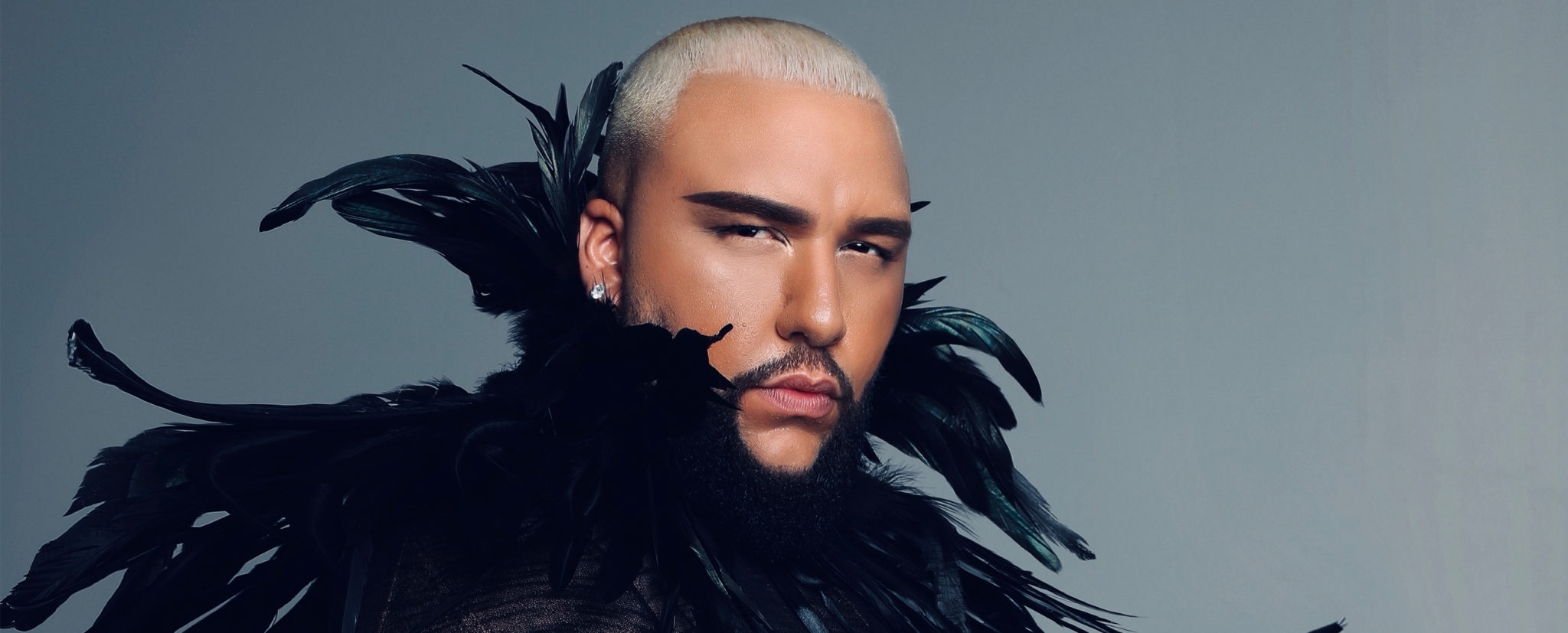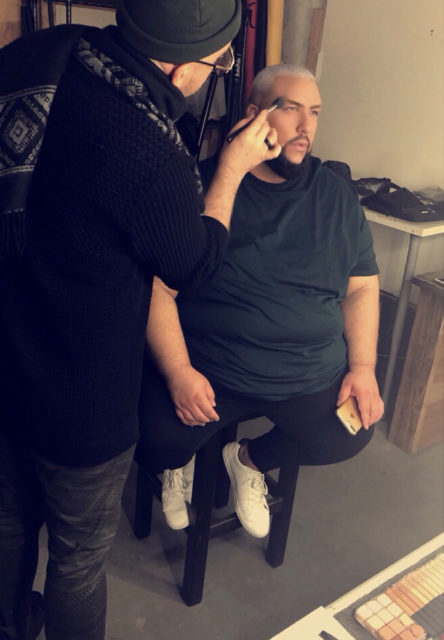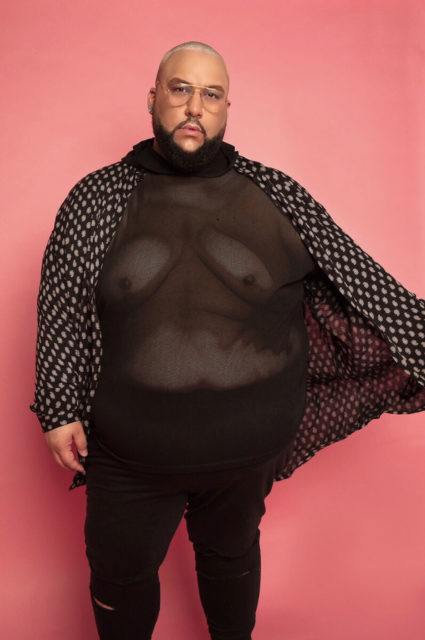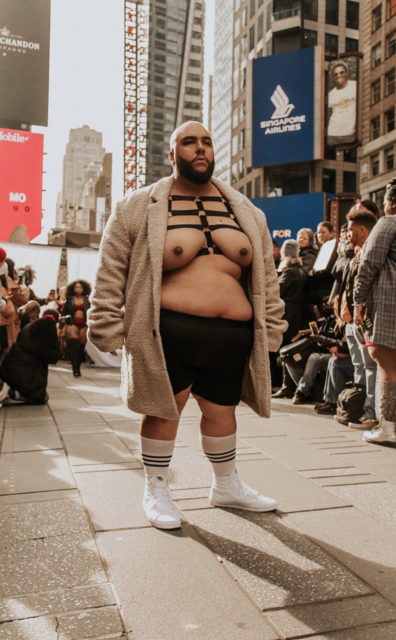
Photo by Julio Lopez.
In a small room with a kempt makeup table, a sewing machine, a ring light and a bed, Arcadio “Ady” del Valle begins his morning ritual of makeup application. His face and eyebrows must always be on before picking his outfit of the day and leaving the two-bedroom apartment he shares with his abuela (grandmother). The all-gray space is surprisingly monochromatic for such a decidedly colorful model/artist/advocate. Then again, an unconventional approach is fitting for someone on his way to becoming the fashion industry’s next breakout plus-size model.
“This doesn’t happen to everyone who looks like me,” del Valle says reflexively. “But I need to ride this bull by the horns.”
Del Valle, who is in his early 30s, was born and raised in Boston. His parents split up when he was 10, and his mother and grandmother raised Ady and his sister, Amarillis, although he remained close with his father. After high school, he trained to work as a paralegal, and when his mother moved out of town, he stayed with his abuela so that she wouldn’t be on her own in the city. Growing up, the young del Valle had always been obsessed with fashion: Project Runway, America’s Next Top Model, fashion films, runway shows and celebrity interviews. But he never saw anyone like him on those TV shows. How could a queer, plus-size Puerto Rican man fit into that world?
“I never thought that I could pursue something like this in real life,” he says. “I didn’t know how to express myself the way I wanted to.” Because of his body, he grew up shy and tried not to take up space. He recounts days in his teenage years spent flipping through catalogs for KingSizeDirect, which caters to big and tall men, and enduring frustrating shopping trips where he discovered that sizing on fashionable clothes never went bigger than XXL or a 40-inch waist.

Ady del Valle getting ready for a photoshoot with makeup artist Jarrett Brandon. Photo courtesy of Ady del Valle.
When he was 17, del Valle went to the Gap to buy navy slacks for his high school graduation. Months earlier he had been able to find clothes there that fit, so he was surprised when “they told me they no longer carried my size and I had to seek out big and tall men’s stores, which weren’t near me at all. I had to go there, spend more money and have my pants tailored to fit better.”
Finding clothes has always been hard for plus-size people, especially attire that makes them look good and feel good without emptying their wallets. The “fat tax,” or markups for plus-size customers, has sometimes been rationalized by retailers that claim more fabric and materials are needed to produce larger clothing.
“I remember paying $60 for big and tall Levi’s, when it only costs $40 for smaller sizes,” says del Valle.
In recent years, more options have become available and accessible thanks to brands like Torrid, MVP Collections and ASOS, but while 2018 proved to be one of the most diverse years yet on the runway in terms of race and gender, the industry is still lacking size diversity. There’s been some progress. Larger women like supermodel Tess Holliday have made it onto magazine covers, and plus-size men like Zach Miko and Kelvin Davis have booked modeling gigs for brands such as Target’s Goodfellow & Co label. But del Valle, who wears size XXXXL or larger, is still a self-made anomaly in the world of fashion.
In 2015, del Valle, whose day job at a family resource center involves assisting victims of human trafficking, sexual assault and domestic violence, began posting pictures of himself on social media. Despite his shyness, he saw it as a way to connect with other plus-size people around the world — and to build his own confidence. He began with simple selfies, “serving face” or featuring the occasional outfit of the day. Soon, his #ootd grew into regular Instagram postings. The feedback was mainly positive, with users approving of his style and applauding him for being so forward with his fashion. His Instagram presence led to an invitation from the brand Volare to walk in their 2016 New York Fashion Week show.
With newfound confidence after the show, del Valle doubled down on his self-promotion, seeking out more opportunities to work in the fashion industry. His style, street with notes of glamour, was well-received, but he wanted to take more risks. So one warm July morning, while walking along a quiet Massachusetts beach with his cousin, he decided to do something that might not seem noteworthy to many people, but which was a crucial step for him: He took his shirt off and posed for a photograph between two boulders.

The first time del Valle went shirtless in public at a beach. Photo courtesy of Ady del Valle.
It took him a week to post the picture, nervously anticipating what people would say about his body. After he finally gathered the courage to post it, the image quickly took off; it was featured on The Huffington Post within 24 hours. It was a turning point for del Valle.
While body shaming has driven many a person from social media, del Valle’s experience posting revealing photos has been largely positive.

Del Valle’s first-ever professional shoot, for the EveryMan project. Photo courtesy of Tarik Carroll.
“Social media became my therapy,” he says. Posting pictures of himself shirtless or in his underwear, coupled with messages about self-love and body acceptance, grew his following and sent his confidence skyrocketing. His posts catalyzed two more runway shows, got him mentioned in magazines, and launched him to “influencer” status, with more than 13,000 followers on Instagram. He’s since collaborated on the EveryMAN Project and #WeAreBigAndTall, two photography projects designed to destigmatize how we perceive the size of men’s bodies.
On December 1, 2018, del Valle stood behind a black curtain in the middle of Times Square. Hundreds of people surrounded the concrete runway, anticipation and chatter filling the air. Del Valle’s phone buzzed with notifications from excited social media followers.
The Real Catwalk, an event created by America’s Next Top Model finalist KhrystyAna Kazakova, called on all people, regardless of shape, size, gender expression, color or ability, to represent themselves by strutting their stuff on the catwalk. Del Valle had connected with Kazakova after social media followers suggested that the two collaborate, and now attendees in the crowd were yelling del Valle’s name.
“This was my moment to face everything I’ve experienced and stand up for those who feel voiceless,” he says, recalling what went through his mind as he stepped onto the catwalk wearing only shorts, a trench coat and a black harness by Bawdy Love Clothing. “Wearing it showed that, yes, I’m big, yes, I look amazing, and, yes, I’m sexy, and that I can be all of those things together,” he says. Bawdy Love Clothing has since designed the Arcadio Harness in his honor.

Del Valle at the Real Catwalk in Times Square. Photo courtesy of Holly Grace Jamili.
Del Valle is still balancing his 9-to-5 with his burgeoning modeling career. If full-time modeling doesn’t work out, he wants to find other opportunities in the fashion industry, and he is playing with the idea becoming a designer who creates universal pieces for all body types. (At 26, he asked his abuela to teach him how to sew, so that he wouldn’t have to keep asking her to tailor his clothes for him.)
He is fueled by a desire to create more opportunities, not just for himself but also for people like him.
“I want to show that normal can also mean different,” he says. Del Valle frequently uses his growing platform to spotlight and congratulate other models who break the mold, and he collaborated with photographer Travis Curry on #IEmbraceMe, an editorial-style photo series celebrating body diversity. The project features models with a wide variety of body sizes, weights, colors and abilities — with no photo retouching or airbrushing.
Del Valle served as a logistical manager for their project, placing an open call for models, casting them and offering support throughout the shoots. Del Valle was “everyone’s cheerleader,” says Curry, adding that “Ady inspires many people with the way he embraces and shows his body … I know that seeing Ady in photos has helped me embrace my own body more.”
In his Instagram Stories, del Valle often shares conversations he’s had with casting offices and brands, nudging them to do more to support body-positive fashion, while also praising the ones that already do.
“My purpose is to be about more than just body positivity,” he says. “I want to represent my people and my culture: LGBTQ, Latino and plus-size.”

Image from the photo series “IembraceMe.” Photo courtesy of Travis Curry.
While there are plenty of queer influences in the fashion industry, the LGBTQ community is not immune from fat shaming. The phrase “no fats, no femmes” is common on gay dating sites, and a small study conducted in 2016 reported that one-third of gay men say they have experienced anti-fat bias. Del Valle says that he has faced plenty of it himself, but lately he’s been pleased by how supportive the community has been of his success.
“I think that with the LGBTQ community being [such a big] a part of fashion, they are loving the fact that someone of size can hold their own in this industry,” he says. Del Valle is the cover model for Obvious Magazine’s March 2019 issue. He believes he’s the first queer, plus-size man to front the fashion publication.
Yet perhaps the most radical thing about Ady del Valle is still his daily Instagram feed, where he redefines who can be a model simply by refusing to adhere to plus-size fashion restrictions like hiding your body with baggy clothing, minimizing it with layers, and not wearing cuts that go above the knee.
“This opens the door for a lot of things that are overlooked or ignored,” del Valle says. “Whether being queer or a person of size, we should all have a spot to take up the space that we deserve.”